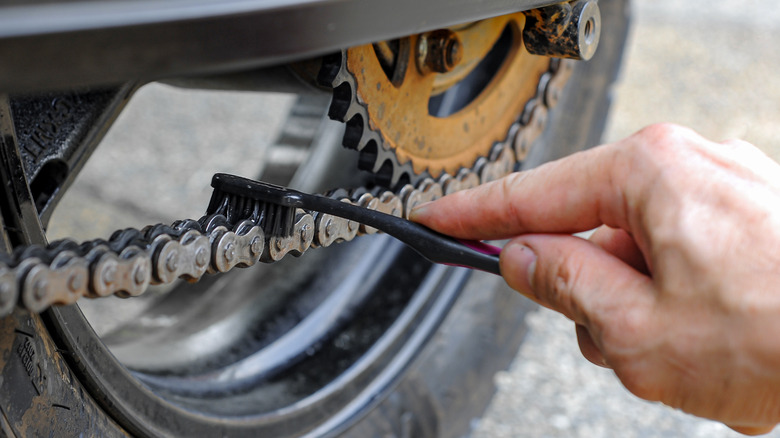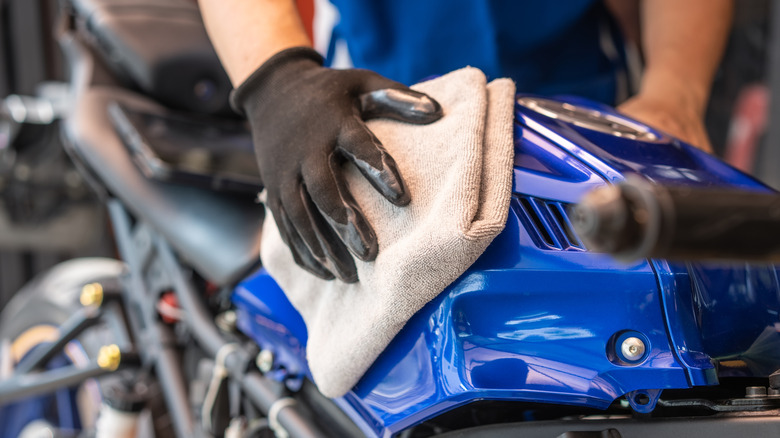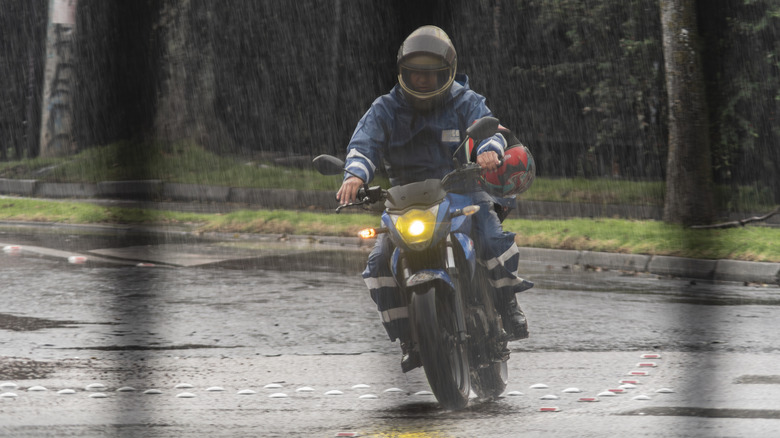What You Need To Do After Riding Your Motorcycle In The Rain
Riding a motorcycle in the rain might be exhilarating in the moment, but it comes with a set of concerns. It's bound to occur if you log enough hours on a bike, especially while living in a climate prone to precipitation. Though not quite as dangerous, it's like hitting a pothole — to be avoided if possible, but it happens from time to time. Confident and experienced riders might even feel comfortable driving in the rain, where the right adjustments and gear, combined with a safe and reputable bike, get you from A to B safely. But riding in the rain presents issues both in the moment and afterwards, when it comes to post-ride maintenance.
Initial concerns include reduced visibility and slippery roads, followed by assessing damage to electrical systems and brakes. General motorcycle care is important — and not overly difficult for most — to ensure that rainwater, debris, and dirt don't damage your bike, as corrosion and electrical issues could arise if neglected. Whether you have a classic ride with a carburetor or the most advanced, newest, fuel-injected bike, rain will always cause concern. Here we will explore everything you need to do after riding a motorcycle in the rain, from inspecting your bike, cleaning it, taking care of gear and rider health, all to help you stay safe and stay riding.
Inspecting and cleaning a motorcycle post-ride
After returning from a wet ride, the first thing most riders will surely do is find a change of clothes, unless they were prepared with proper rain gear. But tending to a wet motorcycle requires immediate attention to ensure everything keeps running smoothly. A bike owner should first conduct a walk-around inspection to assess the general state of the machine. Driving in high winds and stormy conditions, combined with rain, could spray dirt and debris in hard-to-reach places. Scan for any fluid leaks, loose parts, or visible road debris like twigs, small rocks, etc. Tires should be properly inflated, and tread wear should be reviewed.
Next, brake functionality should be reviewed, as wet conditions can affect performance. This is especially critical for those who may find themselves in wet conditions semi-regularly. Checking chains and cables for visible rust and corrosion is also important, replacing them if necessary. If you plan on storing your bike afterward for an extended period of time, as you might do for a winter pause, taking your bike for a quick spin the following day — once dry — can help expel any lingering moisture in the exhaust system, which can help to avoid corrosion in the exhaust pipes.
Cleaning
Following an inspection of the bike, cleaning is recommended to keep things running smoothly. Washing the motorcycle will allow for a more surface-level oversight, where riders can visually inspect the various bike systems as they go. However, a deep dive into checking over the mechanical and electrical components of a bike thoroughly once clean and dry is a good idea.
Before washing, it's recommended that the bike is cool to the touch to prevent thermal shock and burns. If a rider has access to a hose and running water, using a gentle soap and sponge can help to remove any dirt and grime that may be coating components. A microfibre cloth can then be used to thoroughly dry the bike, ensuring all exposed parts are as dry as possible. Doing so provides one last chance to review for any visible rust or corrosion. Lastly, cleaning the chain may be necessary, followed by a quick and easy application of lubricant.
Gear and preparedness
Riding in the rain may not be comfortable for those who aren't prepared, and unpredictable weather can happen to anyone. But having rain gear on hand at all times can help riders stay dry when the weather changes. Stowing waterproof rain gear in saddle bags, as well as a change of clothes, will help with being comfortable and safe after a ride. If you do have to ride in cold rain for extended periods, getting warm once home is essential. Hot beverages and perhaps a hot shower will allow riders to warm up and relax after a stressful rainy trip.
Preparedness is key to avoiding unfavorable weather and any negative ramifications. Checking the weather before a ride and postponing any trips where rain is forecasted is recommended, especially for those who are inexperienced or uncomfortable on wet roads. If you don't own rain-proof riding gear, it may be worth investing in some new kit. Head to your local motorcycle shop and try on some rain gear that fits your budget and climate, while getting expert advice.
Lastly, visibility is always important for motorcyclists, but perhaps even more so in rain, as stopping abruptly can be challenging. Making sure the appropriate riding gear is clean and ready to go, with reflective components intact, is key for safety. Riding in the rain can be sketchy, but with the right measures in place, it doesn't have to be intimidating.



